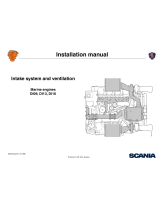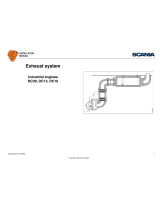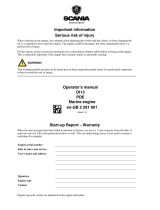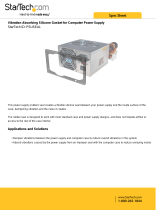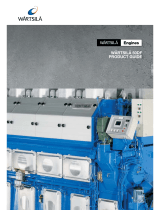Page is loading ...

INSTALLATION
MANUAL
©
Scania CV AB 2016, Sweden
02:04 Issue 7.0 en-GB 1
Exhaust system
Marine engines
DI09, DI13, DI16
333 380

INSTALLATION
MANUAL
©
Scania CV AB 2016, Sweden
02:04 Issue 7.0 en-GB 2
Sound reduction.......................................................................................................3
Exhaust noise....................................................................................................... 3
Exhaust system design ........................................................................................ 4
Connection of exhaust system to engine ................................................................7
V-clamp............................................................................................................... 7
Exhaust pipe bends.............................................................................................. 8
Weld flanges for connection to turbocharger.................................................... 11
Exhaust bellows................................................................................................. 12
Exhaust back pressure ..........................................................................................13
Measuring exhaust back pressure...................................................................... 13
Type of exhaust system .........................................................................................14
Wet exhaust system........................................................................................... 15
Insulating the exhaust system...............................................................................17
Protection against water ingress ..........................................................................19
Multi-engine installation.......................................................................................20
Dimensioning the exhaust system ........................................................................22
Calculation example.......................................................................................... 23
Important data....................................................................................................... 25

INSTALLATION
MANUAL
©
Scania CV AB 2016, Sweden
Sound reduction
02:04 Issue 7.0 en-GB 3
Sound reduction
Assess the need for sound reduction in new installations from case to case, based on
the applicable conditions in relation to noise requirements, length and type of exhaust
system, location of the exhaust system outlet etc.
Some form of sound reduction is required in most installations.
The thermal insulation of the exhaust system affects the sound level. A thermally in-
sulated system can result in a higher noise level than an uninsulated system.
Exhaust noise
Undamped exhaust noise, measured 1 metre downstream of the turbocharger at full
power output:
The most important frequency range for exhaust noise is between 50 and 500 Hz. Ex-
haust flow in the system can generate hissing sounds, e.g. at sharp pipe bends and
edges. This is known as self-generated sound. This phenomenon occurs higher up in
the frequency range and is effectively dampened with an absorption silencer (e.g.
glass fibre). Vibrations in the silencer casing can also generate noise. For this reason,
avoid silencers with flat surfaces.
Engine Sound level (dBA) Most important one-third octave
band (Hz)
DI09 115-117 40-160
DI13 115-118 50-200
DI16 116-118 63-250

INSTALLATION
MANUAL
©
Scania CV AB 2016, Sweden
Sound reduction
02:04 Issue 7.0 en-GB 4
Exhaust system design
Position the silencer as close to the end of the exhaust system as possible. In order to
obtain the best noise reduction, there should only be a short tailpipe after the silencer
as shown in the graph.
• For all-speed engines, read the specified maximum speed for the engine.
• For single-speed engines, read the operating speed of the engine.
If the silencer cannot be positioned close to the exhaust system outlet because of a
lack of space, it should be placed as close to the engine as possible. This location is,
however, unfavourable in silencing terms if the pipes beyond it are long. It may then
be a good idea to install another silencer close to the outlet or to end the exhaust sys-
tem with two 90° pipe bends with a suitable length between them.
Note:
Sharp exhaust pipe bends close to the outlet increase the risk of hissing sounds.
1
2
3
1200
2.0
L(m)
rpm
1.8
1.6
1.4
1.2
1.0
0.8
1500 1800 2100 2400
337 694
Graph for determining the longest length of tailpipe.
1. DI09.
2. DI13.
3. DI16.

INSTALLATION
MANUAL
©
Scania CV AB 2016, Sweden
Sound reduction
02:04 Issue 7.0 en-GB 5
Exhaust outlet
Design the exhaust system so that the exhaust gases are not reflected against vertical
walls, since this results in increased noise level.
Position the exhaust outlet so that no exhaust gases can be drawn into the engine in-
take. If exhaust gases are drawn into the intake, intake air temperature increases rap-
idly. The exhaust gases contain soot particles so there is also a risk of the air filter
becoming blocked.
WARNING!
Position the exhaust outlet so that exhaust gases cannot enter areas occupied by peo-
ple.
Example
If 2 silencers are used in the system, they should be positioned in series at a distance
of 2/3 of the length of the tailpipe and with the silencer used to dampen high-frequen-
cy noise furthest away from the engine.
Since the pipes which form part of an exhaust system also operate as silencers, it is
important that they are dimensioned correctly.
Note:
The exhaust back pressure increases with the number of pipe bends and with in-
creased pipe length. This leads to higher fuel consumption and loss of power.
IMPORTANT!
The installer is responsible for ensuring that the exhaust system is well sealed during
installation. He is also responsible for ensuring that the pipe and silencer suspension
is designed in such a way that system leaks cannot arise during operation.

INSTALLATION
MANUAL
©
Scania CV AB 2016, Sweden
Sound reduction
02:04 Issue 7.0 en-GB 6
Examples of long exhaust systems (i.e. longer than 5 metres) with designs which aid
sound reduction.
Examples of short exhaust systems with designs which aid sound reduction.
L = Length of tailpipe, determined from graph
a = 2/3 of L. Length a is less significant in exhaust systems with only one silencer
338 555
338 554
aL
338 556
L
a
338 557
L
a
a
L
338 558

INSTALLATION
MANUAL
©
Scania CV AB 2016, Sweden
Connection of exhaust system to engine
02:04 Issue 7.0 en-GB 7
Connection of exhaust system to engine
There should always be a flexible connection between the exhaust system and the en-
gine which absorbs the movement of the engine and changes in length in the exhaust
system due to temperature changes. A flexible connection can consist of the Scania
exhaust bellows. Position the flexible connection as close to the turbocharger con-
nection as possible.
IMPORTANT!
The weight of the exhaust system must not load the exhaust bellows or turbocharger.
Therefore, place a suspension point immediately after the flexible connection.
The illustration to the right shows the recommended installation of the exhaust sys-
tem.
If the exhaust pipes are very long or if the exhaust system has a relatively long hori-
zontal part between 2 vertical parts, several flexible connections may be required in
the system. There must then be a fixed anchorage point on one side of the vertical
exhaust bellows and a suspension which allows axial movement on the other side.
V-clamp
Scania pipe sections have flanges secured with V-clamps.
Note:
Do not use the V-clamp to force together joints, but only to fix the flanges.
1
2345
369 312
Recommended installation of exhaust system.
1. Turbocharger.
2. Exhaust pipe bend.
3. Exhaust bellows.
4. Exhaust pipe.
5. Bracket.
338 567

INSTALLATION
MANUAL
©
Scania CV AB 2016, Sweden
Connection of exhaust system to engine
02:04 Issue 7.0 en-GB 8
Exhaust pipe bends
Dry exhaust pipe bends
The engines can be equipped with a 90° exhaust pipe bend on the turbocharger ex-
haust outlet. The exhaust pipe bend can be fitted at different angles and rotated 360°
around the connection with the turbocharger.
The exhaust pipe bend is connected to the turbocharger with a V-clamp.
The exhaust pipe bend outlet has a flange that is connected with a V-clamp. It is usu-
ally connected directly to the Scania exhaust bellows.
On DI16 XPI a flange is connected between the turbocharger and exhaust pipe bend.
The flange, which is marked in grey in the illustration, is connected with 4 Ø 11 mm
screws.
12
Ø
185,3
Ø
185,3
56
148
128
129
195
357 881
1. Exhaust pipe bend for the DI13 072/077.
2. Exhaust pipe bend for the DI09, DI13 except for 072/077 and the DI16 The flange
marked in grey is only used on DI16 XPI.

INSTALLATION
MANUAL
©
Scania CV AB 2016, Sweden
Connection of exhaust system to engine
02:04 Issue 7.0 en-GB 9
Water-cooled exhaust pipe bends
DI09, DI13
For engines with heat exchangers, there are also water-cooled exhaust pipe bends.
They have outlets to fit an exhaust gas temperature sensor (1), thread 1/8-27 NPTF.
The upper illustration shows an example of a water-cooled exhaust pipe bend for
DI09 and DI13. The table gives the measurements for all water-cooled exhaust pipe
bends for DI09 and DI13.
IMPORTANT!
The exhaust pipe bend and hose or pipe downstream of it must not be angled higher
than the bottom edge of the turbocharger, i.e. 15° (see illustration). Otherwise, water
can penetrate into the back of the engine and cause liquid slugging. This may lead to
bent connecting rods and the total destruction of the engine.
This applies to the entire exhaust installation downstream of the turbocharger.
Engine type Dimensions (mm)
ABC
DI09 246 437 423
DI13 072 200 437 434
DI13 077 199 495 433
Other DI13 146 454 400
1
338 206
A
B
C
Ø150
Example of a water-cooled exhaust pipe bend for DI09 and DI13.
M
i
n
1
5
367 912
Minimum installation angle for DI09 and DI13.

INSTALLATION
MANUAL
©
Scania CV AB 2016, Sweden
Connection of exhaust system to engine
02:04 Issue 7.0 en-GB 10
DI16
The illustrations below show the dimensions of the water-cooled exhaust pipe bends
for DI16.
1 = Outlet to fit an exhaust gas temperature sensor, thread 1/8-27 NPTF.
DI16 PDE. DI16 XPI.
1
338 207
291
478 477
Ø
1
5
0
515
1
357 879
369
458 458
Ø
1
5
0
484,5
410

INSTALLATION
MANUAL
©
Scania CV AB 2016, Sweden
Connection of exhaust system to engine
02:04 Issue 7.0 en-GB 11
Weld flanges for connection to turbocharger
The engines can be ordered with a weld flange for connection to the turbocharger.
338 168
Ø102
1
23
Ø125
Ø90
24
5
35
4
60
4
Ø115
Ø125
Ø115
1. DI09 and DI13 except 072/077.
2. DI13 072/077.
3. DI16. The illustration shows the weld flange for DI16 PDE, but the weld flange
for DI16 XPI has the same dimensions downstream of the turbocharger. It is con-
nected with 4 Ø 11 mm screws.

INSTALLATION
MANUAL
©
Scania CV AB 2016, Sweden
Connection of exhaust system to engine
02:04 Issue 7.0 en-GB 12
Exhaust bellows
The Scania exhaust bellows consists of 2 flexible sections with several layers of cor-
rugated stainless steel plate that are connected to a short pipe. The exhaust bellows
can absorb both longitudinal and lateral movements. It allows a maximum simulta-
neous lateral movement of ±20 mm and a longitudinal movement of ±10 mm.
The exhaust bellows has an inside diameter of 127 mm and flanges that are secured
with a V-clamp. It is supplied with a loose flange that is welded to the pipe which is
to be connected to the exhaust bellows.
The loose flange supplied with the exhaust bellows can be selected with different in-
ner diameters for connection to different pipe diameters. Available inner diameters
(A) are 130 or 155 mm for DI09 and DI13, and 114 and 130 mm for DI16.
Use the sealant with part number 1 373 091.
338 559
±10 mm
20 mm20 mm
300 mm
338 561
Ø185
Ø170
0.5±0.05
A
8
20°
338 562

INSTALLATION
MANUAL
©
Scania CV AB 2016, Sweden
Exhaust back pressure
02:04 Issue 7.0 en-GB 13
Exhaust back pressure
The back pressure in the exhaust system must not exceed the maximum recommend-
ed exhaust back pressure, including silencers. A higher exhaust back pressure leads
to increased fuel consumption and a loss of power.
The maximum recommended exhaust back pressure is 100 mbar for all engines.
If the exhaust back pressure is above the maximum recommended value, this has a
negative impact on engine performance.
Always check the exhaust back pressure when installation is complete.
Measuring exhaust back pressure
Perform the measurement on a straight section of the system approximately 1 metre
downstream of the turbocharger.
A simple device for measuring exhaust back pressure is a transparent plastic hose.
Connect the hose to a test connection on the exhaust pipe as illustrated. Bend the hose
and fill it part-way with water.
Drill a hole with 2.0 mm diameter in the exhaust pipe. It is important that the hole on
the inside of the pipe has a clean, sharp edge. Residual burrs and unevenness can re-
sult in significant measurement errors.
First warm up the engine and then run it at maximum load and full load speed. At the
same time, measure the level difference (a) of the water in the hose.
This is a direct measurement of exhaust back pressure in mmH
2
O. 1,000 mmH
2
O is
equal to 100 mbar.
338 560
a
1
2.0
2
Example of exhaust back pressure measurement.
1. Pipe.
2. Plastic hose.

INSTALLATION
MANUAL
©
Scania CV AB 2016, Sweden
Type of exhaust system
02:04 Issue 7.0 en-GB 14
Type of exhaust system
Both dry and wet exhaust systems are found in marine installations.
Dry exhaust systems are preferable in the case of vertical exhaust outlets. Dry ex-
haust pipes must be insulated to reduce the temperature and the risk of fire.
For installations with exhaust outlets in the stern or at the sides more or less level
with the engine exhaust connection, wet exhaust systems are recommended.
In this case, sea water is brought in and mixed with the exhaust fumes, which results
in dampening of the noise level and a lower exhaust temperature. After the connec-
tion point for the sea water, the exhaust system does not need to be insulated.
A very short exhaust system can be fully encased in water. If so, no silencer is need-
ed.

INSTALLATION
MANUAL
©
Scania CV AB 2016, Sweden
Type of exhaust system
02:04 Issue 7.0 en-GB 15
Wet exhaust system
The exhaust system outlet should always be positioned above the water line, even
when the vessel is heavily loaded. The system must slope downwards towards the
outlet. The outlet must always be lower than the water inlet in the system to prevent
water from entering the engine. If the exhaust system outlet is higher than the engine
exhaust connection, the exhaust system must be designed with a water lock that pre-
vents water from entering the engine when stationary.
If a mixing vessel is used in the wet exhaust system as a water lock and to suppress
noise, the lifting height for the gas and water mixture must not be so great that the
total exhaust back pressure is above 100 mbar. The mixing vessel must hold at least
the amount of water that is drained from the system when the engine is stopped.
The most common type of water lock (when the exhaust connection on the engine is
lower than the water line) is an upward-facing, jacketed exhaust bend at a height of
at least 350 mm above the exhaust system outlet. See illustration.
If the engine is installed in such a way that the exhaust connection is located at least
350 mm above the water line, it is possible to connect a jacketed exhaust pipe with
water inlet after the flexible pipe on the exhaust outlet from the engine. See illustra-
tion on next page.
The jacketed exhaust pipe is then connected to the board lead through with a rubber
exhaust hose. Only corrosion-resistant hose clamps may be used for the rubber hoses.
326 460
min
350
WL
VL
122
45 637
Wet exhaust system with engine exhaust connection below the water line.
1. Exhaust connection to turbocharger.
2. Flexible pipe.
3. Mounting bracket.
4. Sea water inlet to jacketed exhaust pipe bend, diameter 50 mm.
5. Jacketed exhaust pipe bend.
6. Rubber exhaust hose.
7. Board lead through.

INSTALLATION
MANUAL
©
Scania CV AB 2016, Sweden
Type of exhaust system
02:04 Issue 7.0 en-GB 16
The jacketed exhaust system can be connected directly to the sea water line outlet.
The connection diameter must be at least 50 mm.
The material in the jacketed exhaust pipe must be corrosion resistant. It must not be
copper or copper alloy.
IMPORTANT!
The weight of the exhaust system must not load the exhaust bellows or turbocharger.
Therefore, equip the exhaust system with suspension or supports.
IMPORTANT!
Equip engines that have a sea water-cooled exhaust system comprising rubber hoses
with a warning system that triggers an alarm in the event of high temperature. Oth-
erwise, there is a risk of the hoses overheating if the sea water pump malfunctions or
the sea water intake becomes blocked.
Design the water intake to the rubber hose so that the spread of water over the surface
of the hose is assured even at low engine speeds when the sea water flow is also low.
326 461
1
WL
VL
min
350
23 5 6 7
4
Wet exhaust system with engine exhaust connection above the water line.
1. Exhaust connection to turbocharger.
2. Flexible pipe.
3. Mounting bracket.
4. Sea water inlet to jacketed exhaust pipe bend, diameter 50 mm.
5. Jacketed exhaust pipe.
6. Rubber exhaust hose.
7. Board lead through.

INSTALLATION
MANUAL
©
Scania CV AB 2016, Sweden
Insulating the exhaust system
02:04 Issue 7.0 en-GB 17
Insulating the exhaust system
Assess on a case-by-case basis whether the exhaust system requires thermal insula-
tion.
If the engine intake air is taken from the engine compartment, exhaust pipes should
be insulated especially well to keep down the temperature in the engine compart-
ment.
Other reasons for insulating the exhaust system are to prevent burn injuries to per-
sonnel, reduce ventilation costs or reduce the risk of fire from the discharge of fluids,
such as hydraulic oil. The exhaust system may also require insulation if there are lead
throughs made of or near flammable material.
Insulation must withstand a temperature of at least 700°C and must always be pro-
tected from splashes closest to the engine.
Note:
The part of the exhaust system that connects to the outlet flange from the turbocharg-
er must always be insulated.
The outer shell of the insulation must be so well sealed that fibres from the insulation
cannot come loose during vibration and block the air filter. The insulation of long
pipes affects the exhaust back pressure. The diameter of the exhaust system should
therefore be increased if it is insulated. An insulated system can increase the noise
level at the outlet. This should also be considered when determining the measure-
ments.
Values for insulated exhaust systems can be found in 02:06 Technical data.
338 563

INSTALLATION
MANUAL
©
Scania CV AB 2016, Sweden
Insulating the exhaust system
02:04 Issue 7.0 en-GB 18
IMPORTANT!
Design the insulation so that the flexible part of the exhaust system is not restricted
in its movement. It must also be possible to inspect the exhaust system without dam-
aging the insulation during dismantling.

INSTALLATION
MANUAL
©
Scania CV AB 2016, Sweden
Protection against water ingress
02:04 Issue 7.0 en-GB 19
Protection against water ingress
If rain or condensation enters the engine, it will cause corrosion damage and, in the
worst cases, liquid slugging. This could result in bent connecting rods and the total
destruction of the engine. Therefore, design the exhaust system so that water ingress
is prevented. Equip long exhaust systems with a condensation separator. Position this
as close to the engine as possible, but after the flexible connection.
The occurrence of condensation is greater with a vertical exhaust system since the
exhaust gases in a horizontal system carry away much of the condensation. Even with
short exhaust pipes, it may be a good idea to fit a condensation separator if there is
any risk of rain water entering.
Equip vertical exhaust outlets with a device that prevents water ingress. The illustra-
tion shows the design of a short vertical exhaust system with a condensation separa-
tor. Also connect a drainable water trap to the condensation separator.
338 564
1
2
3
4
5
6
7
8
9
10
1. Device for protecting against water ingress.
2. V-clamp.
3. Silencer.
4. Connecting flange.
5. Gasket.
6. Condensation separator.
7. Bracket.
8. Flexible connection (exhaust bellows).
9. Engine.
10. Exhaust pipe bend.

INSTALLATION
MANUAL
©
Scania CV AB 2016, Sweden
Multi-engine installation
02:04 Issue 7.0 en-GB 20
Multi-engine installation
Multi-engine installations should have separate exhaust systems for each engine, if
possible.
If the exhaust pipes for several engines are linked to a common exhaust system, the
exhaust systems for each engine should first be calculated individually using the de-
scription below.
Then calculate the necessary area (A tot) for the common exhaust system by adding
together the areas of the exhaust systems for the individual engines.
If the engines are of the same type, read off the diameter for the common system in
the table.
If the engines are of different types, calculate the diameter of the common pipe (d
gem) using the formula on the right.
Number of engines Diameter
1d
21.41 x d
31.73 x d
42.00 x d
52.22 x d
62.45 x d
338 565
d gem =
4 x A tot
3,14
Formula for calculating the diameter with different engine types.
/

